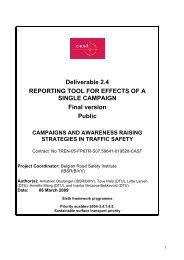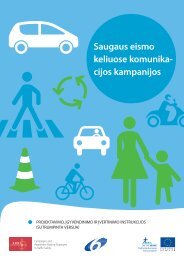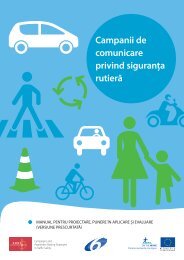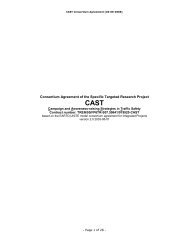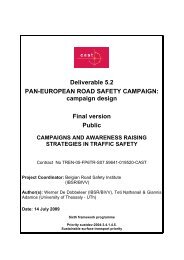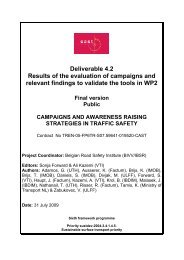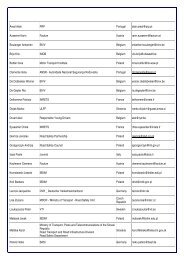Deliverable D 1.3 RESULTS OF META-ANALYSIS ... - cast-eu.org
Deliverable D 1.3 RESULTS OF META-ANALYSIS ... - cast-eu.org
Deliverable D 1.3 RESULTS OF META-ANALYSIS ... - cast-eu.org
Create successful ePaper yourself
Turn your PDF publications into a flip-book with our unique Google optimized e-Paper software.
Campaigns and awareness raising strategies in traffic safety — <strong>Deliverable</strong> D-1.1important aspects of campaign content are associated with campaignoutcome. Specifically, we could not consider how the use of emotion,addressing the social norm, or identifying and consulting a target groupaffected campaign outcome on accidents. Neither could we consider the fullrange of delivery channels, although we consider that the most important arecaptured in some way in the final model. Some delivery channels, such asposters, were not captured because we they were simply too difficult toclassify. In summary then, there are important aspects about the delivery andcontent of the campaign that are not accounted for in the final accident model.Notwithstanding these reservations, and making the assumptions described insection 8.1.1, we conclude the following. Campaigns with a drink-drive themetend to have larger reduction in accident counts. Campaigns of duration nolonger than one month are also associated with greater reductions, thoughthis result should be treated with caution since it is based on seven effects.Delivery of the campaign message at the roadside, using a billboard, fixed orvariable message sign, is also associated with accident reduction. There issome support for previous findings that personal influence and enforcementare associated with increased accident reductions. These associations werein the expected direction and close to significance. Recent campaigns appearto have been less effective than earlier ones, and use of combined massmediachannels is associated with less favourable accident outcomes in ourmodel. Checks of the model for various potential problems indicate that it isrobust, although a split-half analysis of the data was inconclusive.We now turn to consider what influences the effect of campaigns on seatbeltuse.8.3 FACTORS ASSOCIATED WITH CAMPAIGN EFFECT ONSEATBELT USEUsing the process described in section 8.2, 22 variables were chosen ascandidates for the explanation of variance in seatbelt effects (Table 8.3).The variable [limited area] was introduced to control for the findings in chapter7, that there appeared to be several effective small-scale seatbelt campaignsin the database, along with observations that many campaigns targeted a‘captive audiences’, by targeting the campaigns within very limited areas, suchas car parks, drive-in, hospital or other <strong>org</strong>anisations. This variable wasclassified as a deliverable variable that was distinct from [scale-local], to whichit did not correlate strongly.The model was developed by considering statistical properties of eachvariable, in the following way. Variables with too many missing values wereexcluded such that all remaining variables had a maximum of seven missingvalues. [Social norm], [target consulted], [risk of detection] and [emotional andrational] were excluded on this basis. [Shocking consequences] was excludedbecause there were only five seatbelt use effects reported for campaignsexplicitly using shocking content. Again important variables had to beexcluded that could have important influences on campaign outcomes.106



